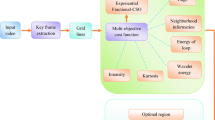Abstract
Presently, the technological advancements in electronics and networking fields have resulted in the massive rise in the communication of digital information, especially videos. Since users access Internet in an open channel, the digital data can be altered or tampered with easily. Therefore, encryption and steganography techniques have been developed to ensure secure communication. In video steganography technique, the optimal pixels in the cover video are chosen and the encrypted secret message can be embedded into the chosen pixels, resulting in the generation of stego video. Keeping this in mind, this paper introduces an optimal metaheuristics based pixel selection with homomorphic encryption technique for video steganography (OMPS-HEVS) technique. The proposed OMPS-HEVS technique initially performs frame conversion process and applies a two-dimensional discrete wavelet decomposition (2D-DWT) process. Besides, the optimal pixel selection process takes place using the glowworm swarm optimization (GSO) algorithm. Moreover, Optimal Homomorphic encryption (OHE) with Jaya Optimization Algorithm (JOA) is applied to encode the secret message. The design of optimal key generation process of OHE using JOA helps to accomplish improved security. The experimental validation of the OMPS-HEVS technique on the benchmark test video exhibited the superior performance of the OMPS-HEVS technique over the other existing techniques.







Similar content being viewed by others
Explore related subjects
Discover the latest articles, news and stories from top researchers in related subjects.References
Niu K, Li J, Yang X, Zhang S, Wang B (2019) Hybrid adaptive video steganography scheme under game model. IEEE Access 7:61523–61533
Aljarf A, Amin S, Al-Jarrah MM (2018) Steganalysis system for colour steganographic images using three different techniques. In: Proceedings of the 2018 11th International Conference on Developments in eSystems Engineering (DeSE), Cambridge, UK, 2–5 September 2018; pp. 346–353.
Saito T, Zhao Q, Naito H (2019) Second level steganalysis-embeding location detection using machine learning. In: Proceedings of the 2019 IEEE 10th International Conference on Awareness Science and Technology (iCAST), Morioka, Japan, 23–25 October 2019; pp. 1–6.
Xiang Z, Sang J, Zhang Q, Cai B, Xia X, Wu W (2020) A new convolutional neural network-based steganalysis method for content-adaptive image steganography in the spatial domain. IEEE Access 8:47013–47020
Zhang L, Hu X, Rasheed W, Huang T, Zhao C (2019) An enhanced steganographic code and its application in voice-over-ip steganography. IEEE Access 7:97187–97195
Chen X, Wang S, Shi C, Wu H, Zhao J, Fu J (2019) Robust ship tracking via multi-view learning and sparse representation. J Navig 72:176–192
Zhang L, Chen D (2020) The large capacity embedding algorithm for H.264/AVC intra-prediction mode video steganography based on linear block code over Z4. Multimed Tools Appl 79:12659–12677
Konyar MZ, Akbulut O, Öztürk S (2020) Matrix encoding-based high-capacity and high-fidelity reversible data hiding in HEVC. Signal Image Video Process 14:897–905
Zhu B, Ni J (2018) Uniform embedding for efficient steganography of H.264 video. In: Proceedings of the 2018 25th IEEE International Conference on Image Processing (ICIP), Athens, Greece, 7–10 October 2018; pp. 1678–1682.
Lee W, Sun W (2019) Reversible steganography scheme based on position-recording in DCT coefficients. In: Proceedings of the 2019 15th International Conference on Computational Intelligence and Security (CIS), Macao, Macao, 13–16 December 2019; pp. 424–428
Yao Y, Yu N (2021) Motion vector modification distortion analysis-based payload allocation for video steganography. J Vis Commun Image Represent 74:102986
Liu S, Xu D (2020) A robust steganography method for HEVC based on secret sharing. Cogn Syst Res 59:207–220
Varuikhin V, Levina A (2021) Continuous wavelet transform applications in steganography. Proc Comput Sci 186:580–587
Ramalingam M, Isa NAM (2015) Fast retrieval of hidden data using enhanced hidden Markov model in video steganography. Appl Soft Comput 34:744–757
Ramalingam M, Isa NAM (2016) A data-hiding technique using scene-change detection for video steganography. Comput Electr Eng 54:423–434
Kar N, Mandal K, Bhattacharya B (2018) Improved chaos-based video steganography using DNA alphabets. ICT Express 4(1):6–13
Ramalingam M, Isa NAM, Puviarasi R (2020) A secured data hiding using affine transformation in video steganography. Proc Comput Sci 171:1147–1156
Mstafa RJ, Elleithy KM, Abdelfattah E (2017) A robust and secure video steganography method in DWT-DCT domains based on multiple object tracking and ECC. IEEE access 5:5354–5365
Ouyang Z, Zhou YQ (2011) Self-adaptive step glowworm swarm optimization algorithm. JisuanjiYingyong/J Comput Appl 31(7):1804–1807
Rao R (2016) Jaya: a simple and new optimization algorithm for solving constrained and unconstrained optimization problems. Int J Ind Eng Comput 7(1):19–34
Dhawan KK (2007) Fault tolerance-genetic algorithm for grid task scheduling using check point In: Sixth International Conference on Grid and Cooperative Computing. IEEE, pp.676–680. https://doi.org/10.1109/GCC.2007.67
Zhang Y, Yang X, Cattani C, Rao RV, Wang S, Phillips P (2016) Tea category identification using a novel fractional Fourier entropy and Jaya algorithm. Entropy 18(3):77
Suresh M, Sam IS (2020) Optimized interesting region identification for video steganography using Fractional Grey Wolf Optimization along with multi-objective cost function. J King Saud Univ Comput Inform Sci. https://doi.org/10.1016/j.jksuci.2020.08.007
Sharath MN, Rajesh TM, Patil M (2019) Analysis of secure multimedia communication in cloud computing. In: 2019 2nd International Conference on analysis Intelligent Computing, Instrumentation and Control Technologies (ICICICT), Kannur, India, pp. 136–144. https://doi.org/10.1109/ICICICT46008.2019.8993352.
Yu XY, Wang CY, Zhou X (1891) A survey on robust video watermarking algorithms for copyright protection. Appl Sci 2018:8
Niu K, Li J, Yang X, Zhang S, Wang B (2019) Hybrid adaptive video steganography scheme under game model. IEEE Access 7:61523–61533
Denemark TD, Boroumand M, Fridrich J (2016) Steganalysis features for content-adaptive JPEG steganography. IEEE Trans Inform Foren Secur 11(8):1736–1746
Fridrich J, Kodovsky J (2012) Rich models for steganalysis of digital images. IEEE Trans Inform Foren Secur 7(3):868–882
Jangid S, Sharma S (2017) High PSNR based video steganography by MLC(multi-level clustering) algorithm. In: Proc. ICICCS, Madurai, India
Author information
Authors and Affiliations
Corresponding author
Rights and permissions
About this article
Cite this article
Sharath, M.N., Rajesh, T.M. & Patil, M. Design of optimal metaheuristics based pixel selection with homomorphic encryption technique for video steganography. Int. j. inf. tecnol. 14, 2265–2274 (2022). https://doi.org/10.1007/s41870-022-01005-9
Received:
Accepted:
Published:
Issue Date:
DOI: https://doi.org/10.1007/s41870-022-01005-9




